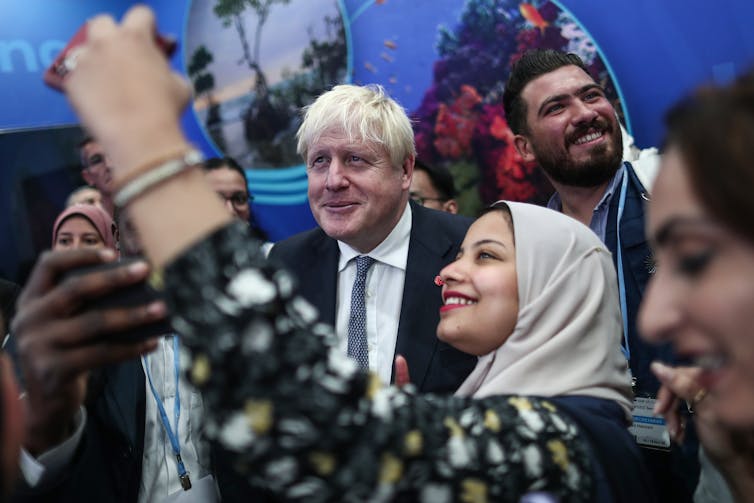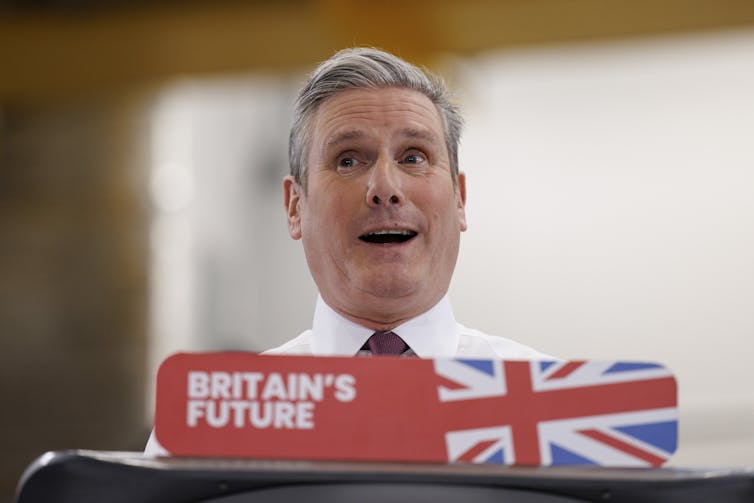Prime Minister Rishi Sunak and Labour leader Keir Starmer will meet in multiple TV debates over the course of the election campaign. Neither is considered a big personality, so this will be a test for both men.
TV debates are an opportunity to reach people who often aren’t fully engaged with politics. For many, this will be the first time they’ve sat down and watched either leader speak for an extended time.
Our research shows that preparation for these debates should not just include issue prep and practising attack lines. Starmer and Sunak should also rehearse their facial expressions, particularly their smiles.

Want more general election coverage and analysis from The Conversation’s academic experts?
Sign up for our new, weekly UK politics newsletter, delivered every Friday throughout the campaign and beyond.
With the right kind of smile, party leaders can sway the voting public quite significantly. To examine this effect, we studied how voter emotions changed during and after the 2019 election in response to seeing party leaders on TV, focusing specifically on how two types of smiles influenced viewers.
The first type was the reward smile, a nonverbal display that expresses positive emotions like happiness and joy, rewarding both sender and perceiver. The second was the affiliative smile, which humans use to convey reassurance and other positive motives that foster and maintain social bonds.
In the 2019 election, the Conservatives won by a large margin, significantly cementing their power over Labour. A lot has changed since, but, at the time, the country was talking about “ten years of prime minister Boris Johnson”, such was the force of his personality. The 2019 campaign was largely personality driven, focused more on the man at the top of the ticket than the party – a circumstance that provided an ideal opportunity to study how nonverbal cues foster emotional connections between politicians and voters.
When a forceful yet personable candidate is in a position to swing an election, not unlike Ronald Reagan in the 1980s or Barack Obama in the 2000s, it is not facile to ask how much a certain kind of charm plays a role. And for Johnson, it is clear that this was the case. For the typical voter, who is not paying close attention to policy proposals and political developments, Johnson’s boyish appeal made a difficult decision easy – vote for the candidate who exudes the most “hail-fellow-well-met” appeal.
Despite his faults, Johnson was very good at reassurance displays – genuine smiles involving a wide grin, a loose jaw, and contraction of the muscles around the eyes. These convey comfort, support and confidence to others in situations where they may feel anxious. With these, he provided a visual invitation for affiliation – the kind that promoted bonding and forged emotional connection. Labour leader Jeremy Corbyn, on the other hand, failed to reassure and connect on this emotional level beyond his support base.
In our study, we examined how the expressive dynamics of Johnson and Corbyn affected voters’ feelings towards them before and then after the election. We looked specifically at whether reward and affiliative smiles influenced how voters evaluated the party leaders. Johnson was the clear winner.
Significant effects were observed for partisanship and smile type, particularly for Johnson, the eventual winner. It was Johnson’s affiliative smile that drove an increase in positive feelings not only among Conservatives but also supporters of Labour and the Liberal Democrats.

Other leaders tested, including Corbyn and then-Liberal Democrat leader Jo Swinson, did not have the same salutary effect on voters. In fact, their smiles were more likely to generate increases in negative emotion or counterempathy – responses that are opposite to the emotion expressed.
After the election, supporters of the two losing parties, especially Labour, reported negative emotions like anger and distress when shown footage of their respective leaders smiling. Yet Labour supporters reported a slight increase in affinity towards Johnson when shown his reward smile, suggesting a blurring of ideological lines.
The smile Sunak and Starmer should copy
As our research makes clear, Johnson’s affiliative smiles performed persuasive work in the 2019 election. Supporters of both Labour and the Liberal Democrats responded quite positively to this particular smile. Unlike Swinson’s expressions, Johnson’s affiliative smile seemed to alleviate anger and distress among Liberal Democrats, possibly due to a desire for certainty amidst the Brexit uncertainty that was rife at the time.
Our findings are the first to show that followers of the losing party can feel more positively towards the eventual winner if they effectively display nonverbal cues during and after the campaign period.

These findings show that a politician who smiles a certain way can have a significant effect on voters. Much of our work was conducted after voters had cast their ballots – but there is still time for Sunak and Starmer.
It might be surprising to hear that people who didn’t vote for a party can feel more positive towards its leader just by seeing them smile, but this is a well-established trait of human behaviour. Studies on affiliative smiles have shown their capacity to generate reciprocal altruistic behaviour. Research from economic games , for instance, has shown that affiliative smiles can motivate others to cooperate and engage in helping behaviour.
The cross-party dynamics of Labour and Liberal Democrat party supporters responding positively to Johnson’s smiles suggests that nonverbal communication, affiliative smiles in particular, can transcend policy differences among segments of the electorate and win over some low information or late deciding voters. And perhaps more importantly, in a time marked by contentious politics, this behaviour provides a means of reassurance that representative democracy will persevere.

